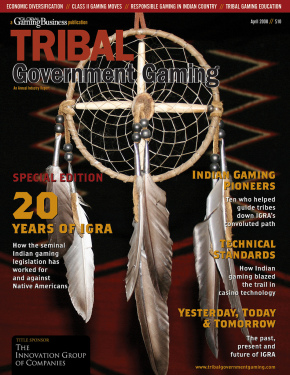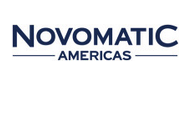
Indian gaming is a relatively new phenomenon. If someone had casually mentioned driving to an Indian reservation to play blackjack in 1978, they’d have been sent to a padded room for observation. But in less than a generation, Indian casinos have become an economic force to be reckoned with-a billion-a-year business, and growing. In addition, the social, political, and cultural impact of Indian gaming goes far beyond dice and slot machines. It has lead to a historic reversal of United States-Indian relations. Once denied their land, forced to assimilate, and marginalized from society, American Indians have gained increasing economic and political power in the last 30 years. And casinos are a big part of the reason.
But casinos didn’t magically appear on the American landscape. The current regime of Indian gaming wouldn’t have been possible without the hard work, perseverance and foresight of dozens of men and women. Indian gaming isn’t something that happened; it’s something that was created deliberately.
We are fortunate to still have most of the innovators and mavericks who created American Indian gaming still with us. Though the general public is still ignorant of the true complexity and significance of the Indian gaming phoenix, those close to the industry know much of the “real story.” And, most importantly, those who built the industry into what it is today are still here, sharing their stories.
It would be impossible to list, let alone chronicle the contributions of everyone who contributed to the advent of Indian gaming. But there are some people whose involvement is noteworthy for both the impact it had and its symbolic importance. Of this group, we are featuring a small fraction in these pages. This is not a definitive list of the most important men and women in Indian gaming; it is merely a way of starting the conversation.
First, some background to put the enormity of the Indian gaming victory in context.
From the initial colonization of the North American mainland by European settlers in the 17th century, the new arrivals systematically pushed Native Americans from their lands. United States policy explicitly sought to end Indian independence: with the passage of the Dawes Severalty Act in 1877, the government actively worked to suppress all traces of traditional culture and language and dissolve tribal governments as legal, land-owning entities. By the turn of the 20th century, Indian land holdings had shrunk to a fraction of their former size.
By the 1930s, it was clear that such policies had not helped Indians assimilate into white American life or achieve material success. So reformers launched an “Indian New Deal.” The Indian Reorganization Act of 1934 brought back collective land ownership and established procedures for self-government. But these efforts did little to improve the lives of Indians. Starting in the late 1960s, budget deficits throughout the nation led many jurisdictions to embrace lotteries and, later, casinos. The national plight of American Indians even more serious, as unemployment, under-employment, and lack of opportunity remained endemic of reservation life. Around this time, the federal government renewed its commitment to encouraging the political, cultural, and economic self-determination and self-sufficiency of Indian tribes.
So it made sense when, in these years, tribes sought to use their last remaining assets-sovereignty and reservation lands-to their benefit. With little possibility for commercial or industrial development and a growing tide of legalization around the country, gaming made perfect sense to tribes desperate for advancement. But few could have predicted just how effective it would become, thanks to the diligence of the men and women chronicled here-and thousands who shared their dedication.

First Things First
Ginny Boylan
Virginia W. Boylan has been deeply involved in Indian law for over 20 years. As deputy staff director and senior counsel to the U.S. Senate Committee on Indian Affairs, she was responsible for legislation and oversight of federal management of Indian trust resources and economic and social services programs, environment, economic development, gaming, energy and minerals development, water and land claim settlements, federal recognition issues, housing and education.
Boylan, currently a partner at Drinker Biddle and Reath, LLP, started work on the bill that became the Indian Gaming Regulatory Act in 1987, at the behest of new Indian Affairs Committee Chairman Daniel Inouye, who had long championed a congressional role in Indian gaming. Two weeks after the bill was introduced, the Cabazon decision unleashed a flood of interest in the bill. In getting the bill passed into law, Boylan pivotally worked to balance pressure coming from several sides: Indian tribes, congressional representatives and the administration.
At the time, neither Boylan nor the bill’s proponents foresaw the large-scale development of Class III gaming. In an era of shrinking federal appropriations for Indian country, Boylan thought IGRA would help bolster Indian economic development and self-determination; her biggest surprise today is that tribes are in the role of providing money to states.
According to Boylan, the bill’s proponents felt commercial gaming would overwhelm Indian gaming, and that they had to pass the bill before this window of opportunity closed. “Instead,” she recently recalled, “states have seen the benefit of confining gaming to tribes, and as a result, both tribes and states have benefited.”

House Edge
Frank Ducheneaux
Frank Ducheneaux has had a long and distinguished role as a key legislative advocate for Indian interests. As legal counsel for U.S. Congress committees charged with Indian policy, he served a pivotal role in shepherding many bills into law, including the Menominee Restoration Act, the American Indian Religious Freedom Act and several other laws that have a significance far broader than gaming. He blended a tireless support for the rights of Indians with an understanding of the legislative process, and is rightfully recognized as one of the framers of the Indian Gaming Regulatory Act.
Joining the staff of the House Interior Committee in 1973, Ducheneaux served on the committee-and its successors-until 1990, after which he continued his work as an attorney, consultant and member of the Minnesota Indian Gaming Association.
A member of the Cheyenne River Sioux Tribe of South Dakota, Duchenaux made history when he became the first Native American to serve as legal counsel to the Interior Committee, giving unprecedented influence on shaping congressional Indian policy.
Ducheneaux exerted his greatest influence on the development of Indian gaming as one of the architects of 1988’s Indian Gaming Regulatory Act, the pivotal piece of legislation that provided the regulatory framework for Class III casino-style gaming on Indian reservations. The idea of an act to systematize Indian gaming had been floating around Congress for a few years, but the Supreme Court’s ruling in the Cabazon case in 1987 jumps-tarted the process.
Back in 1987, it would have been hard to believe that Indian reservations would host a multi-billion dollar-a-year business, but the passage of IGRA in 1988 made the possible. Though Frank Ducheneaux’s legislative legacy is impressive, he deserves equal credit for his role in helping create the framework for this economic and social dynamo.

Legal Action
Glenn Feldman
Without Glenn Feldman’s legal expertise, Indian gaming might have developed quite differently. Feldman, currently a shareholder in the law firm of Mariscal, Weeks, McIntyre & Friedlander of Phoenix, Arizona, has focused on federal Indian law throughout his career. In 1987 he successfully argued the landmark tribal gaming case, California v. Cabazon Band of Mission Indians, before the United States Supreme Court.
Winning a case before the highest court in the land would be the pinnacle of any attorney’s career, but Feldman doesn’t rest on his laurels; he still serves as general counsel of the Cabazon Band, a position he has held since 1979 without interruption, and has continued to advise many other tribes.
After leaving Capitol Hill in 1979, Feldman joined former South Dakota Senator James Abourezk, for whom he had worked in the Senate in private law practice. Since Abourezk had a background in Indian affairs, several tribes sought their services.
The first tribe to do so was the Cabazon Band of Mission Indians, who in the coming year found themselves enmeshed in the first of a series of court cases. When, in 1980, the tribe’s leaders chose to open a card game under California’s “local option” law, police from the nearby city of Indio raided the newly-opened poker room, made several arrests, and declared the enterprise closed. For the next three years, the case wound its way upward to the 9th Circuit of Appeals. That court ultimately ruled that, since the card room wasn’t within the city’s jurisdiction, municipal authorities were powerless to close it.
Shortly thereafter, Riverside County sheriff’s deputies raided and closed the poker room. The county argued that its jurisdiction was incontestable, and the tribe sued to re-open yet again. After winning in both District Court and the 9th Circuit, Feldman and the Cabazon legal team learned in the summer of 1986 that the Supreme Court would hear the case. He felt confident, and knew that if he won the case would set precedents, though he had no way of knowing the magnitude of that precedent.
In the Cabazon decision, the Supreme Court ruled that, if a state permitted a certain type of gambling, its regulation was a matter of civil rather than criminal law, and therefore an Indian tribe whose reservation lies within that state’s borders has the sovereign right to run such games without state restriction. This case centered primarily on card rooms and bingo, though the court concluded that its implications went far beyond gambling: by running high-stakes games, the Cabazon Band was “generating value on the reservations through activities in which they have a substantial interest and they dedicate bingo revenues to promoting the health, education, and general welfare of the tribal members.”
Though Feldman knew he had a strong case, he concedes that, had the Supreme Court ruled against it, Congress likely wouldn’t have passed IGRA in the following year.
“No one could have predicted in 1987 that the Cabazon decision would open the door to a $25 billion tribal gaming industry,” he says, “but those of us who have been involved since the beginning and have seen the many benefits that gaming has brought to Indian Country are proud to have been a part of that history.”

Foxwoods Founder
Richard “Skip” Hayward
Foxwoods Resort Casino is one of the largest casinos in the world, and perhaps the most striking illustration of the power of Indian gaming. Richard “Skip” Hayward is, more than anyone, responsible for both the improbable resurgence of the Mashantucket Pequot and the striking rise of Foxwoods.
Hayward refused to let the Pequot legacy fade after the death of his grandmother, Elizabeth George, who had for years been the sole remaining descendant of the Connecticut Indian tribe living on its small reservation. Securing first state and later federal recognition for the Mashantucket Pequots, Hayward tried several tribal business ventures before hitting the gaming jackpot: high-stakes bingo gave way, in 1992, to a full-fledged casino after Hayward negotiated a compact with Governor Lowell Weicker.
Foxwoods proved to be a casino powerhouse. Located between New York City and Boston, its success proved that New Englanders are just as willing to embrace gaming as those in other sections of the country. Though Hayward was deposed as tribal chairman in 1998, his contributions to both the Mashantucket Pequot and the Indian gaming industry are beyond debate.

Business Savvy
Lyle Berman
Lyle Berman is one of the few Indian gaming pioneers who’s equally accomplished on both sides of the gaming tables. Berman was inducted into the Poker Hall of Fame in 2002, and he owns three World Series of Poker bracelets. But Berman isn’t counted among the most influential figures in Indian gaming history because of his card playing.
Berman helped to found Grand Casinos, which would become one of the first management companies hired by tribes to operate their casinos. He moved into the area almost by happenstance. He had recently sold his leather business, and a friend who had secured contracts to manage two bingo/slot parlors invited him to participate, chiefly because of his poker pedigree. Berman agreed and financed the start-up, becoming president.
After opening day at the Mille Lacs casino, Berman realized how lucrative the business could be, and he quickly took the company public. Berman parlayed his Minnesota success into a small gambling empire, with management contracts in several states. Berman recalls there being several differences between running a Indian casino and operating a private business. The managers are responsible to tribal leadership rather than their own interests, and leaders often let political or cultural concerns override concern for the bottom line.
Minnesota, Berman insists, has been a leader in Indian gaming since the earliest days, though the state has enforced some idiosyncratic rules. There were to be no slot machines, for example; only “video gaming terminals.”
At its peak, Grand also owned and operated three Mississippi casinos. When Park Place Entertainment absorbed Grand Casinos in 1998, Berman spun off its Indian gaming operations into Lakes Gaming, a company that became Lakes Entertainment in 2002. As partial owner of the World Poker Tour, Berman was instrumental in creating-and capitalizing on-the poker boom of the early 21st century.
Berman sees a far different landscape for management companies today than in years past. There aren’t many great opportunities for management companies, since most tribes that want gaming already have it. Still, the future for the industry as a whole is fantastic.
If you want to know, Berman says that running company successfully is a far greater thrill than winning a World Series of Poker tournament. Still poker has value for business, since it “teaches you ramifications for decision-making.” Playing poker, Berman became used to instantly knowing the results of his calculations and hunches, and immeasurably steeled his resolve in making tough choices from executive offices.

The Chairman
Rick Hill
From a young age Rick Hill seemed destined to be a leader, but few could have predicted just how far he would go. Elected to the tribal council of the Oneida Tribe of Wisconsin at the age of 23, he was the youngest member ever to serve his tribe on the council. In 1983 he won election as tribal vice chairman, a post that his father had held for nearly 20 years before his death in that year. Hill’s star continued to rise, and he won the chairmanship of the Oneida in 1990.
Hill served as tribal chairman until 1993, when he stepped onto the national stage. In that year he was elected as chairman of the National Indian Gaming Association, the premier Indian gaming lobbying and public awareness organization. Hill remained chairman and chief spokesman for NIGA until 2001. His tenure as leader of the organization saw incredible victories for Indian gaming and Native Americans, and under his leadership NIGA more than doubled its membership
The changes during Hill’s years at the help of NIGA go far beyond the numbers. Presiding over the group during much of the 1990s, Hill helped to solidify the image of Indian gaming as a legitimate industry and responsible community member.
For Hill, Indian gaming has been a means to an end-the increasing economic empowerment of Native Americans. This goes far beyond casinos. A Washington, D.C., Marriott Residence Inn that opened in early 2005 epitomizes Hill’s vision for the future of American Indians. Under Hill’s guidance, four Indian tribes formed an unprecedented partnership. Joining together with Marriott, they invested in a non-gaming hotel with a perfect symbolic location, three blocks from the National Museum of the American Indian and only five blocks from the U.S. Capitol.

Seminole Sentinel
Jim Shore
Jim Shore is an Indian gaming pioneer whose accomplishments are nearly outweighed by the dramatic story of his life. Born on the Seminole’s Brighton Reservation near Okeechobee, Florida, Shore trained as an auto mechanic before an accident shattered his life-at the age of 25, Shore was permanently blinded after a car crash. Shore didn’t give up, though; he enrolled in Stetson University and studied history before attending-and graduating from-the university’s law school. Shore was the first Seminole to earn a law degree, and on his graduation in 1980 he immediately joined the tribe’s legal team.
At the time, the tribe was in the midst of an epochal legal struggle: the state of Florida attempted to shut down the Seminole’s high-stakes bingo operation, triggering a round of lawsuits that ended in a favorable federal appellate court ruling. The Seminole decision opened the door for the expansion of high-stakes bingo on tribal lands nationwide, and laid the groundwork for the Supreme Court’s favorable Cabazon ruling.
As general counsel for the Seminole from 1982 forward, Shore shaped the tribe’s legal strategy. Though he was unsuccessful in forcing the state to negotiate a Class III compact in 1994, he fought off state attempts to check the tribe’s Class II gaming machines. And Shore was ultimately vindicated when, in 2007 Florida Governor Charlie Crist negotiated a pact that brought full casino gaming to the Seminole casinos.
Shore played a key role in restructuring the tribe’s gambling operations after allegations of impropriety-such a vigorous role that, in 2002, he was shot three times and left for dead in what has been described as a “mob-style hit.” Shore survived, and though his would-be killer has not been brought to justice, he made a complete recovery in time to guide to Seminoles to international providence.
When, in 2004, the Seminoles opened two Hard Rock casinos, they were merely licensing use of the Hard Rock name and brand. In late 2006, at Shore’s urging, tribal leaders jumped at the chance to acquire the entire Hard Rock empire-restaurants, hotels and over 70,000 pieces of rock-and-roll memorabilia. This significant purchase illuminates the newfound economic and cultural vitality of both the Seminole tribes and all Native Americans.

Mille Lacs Miracle
Marge Anderson
Minnesota Indian gaming doesn’t usually get the headlines that casinos in California, Florida, and Connecticut do, but it’s a potent economic force nevertheless; it is the fifth-largest Indian gaming market in the country and has an aggregate statewide economic impact of over a half-billion dollars a year.
Marge Anderson is one of the prime movers behind this taciturn gaming behemoth. As chairwoman and chief executive of the Mille Lacs Band of Ojibwe from 1991 to 2000, she guided the band through a decade of tremendous growth, growth made possible by the success of Grand Casino Mille Lacs and Grand Casino Hinckley.
As leader of the band, Anderson set three priorities that determined how the Mille Lacs reinvested the profits generated from the casinos. She insisted that the band work to strengthen its cultural identity, return to economic self-sufficiency, and increase the prosperity of both the reservation members and their neighbors.
Before the advent of Indian gaming, Minnesota Indian reservations were among the poorest and bleakest in the nation. Now, those same reservations host businesses that employ thousands, Indians and non-Indians alike, while pumping millions of dollars into the state’s economy. Marge Anderson is one of the quiet forces behind this social and economic revitalization.

Ongoing Struggle
Brenda Soulliere
The daughter of former tribal chairman John James, Brenda Soulliere grew up keenly aware of the importance of leadership-and of the terrific responsibilities that comes with authority.
Last year, Tribal Government Gaming described her dramatic confrontation with local authorities, who jailed her for participating in what the Cabazon Band of Mission Indians considered to be legal gaming, in the form of bingo.
For more than 20 years, Soulliere has worked for the Cabazon Band. It has been a momentous tenure. In her early years with tribal administration, the Cabazon decision (1987) and Indian Gaming Regulatory Act (1988) vastly expanded the horizons of Indian gaming. Throughout the 1990s, Soulliere championed the cause of California Indian self-determination and economic development, a campaign that culminated in victories in Propositions 5 (1998) and 1A (2000), and more than 50 state-tribal gaming compacts being signed in 1999.
Class III gaming in California was not an easy fight. During the 1998 campaign Nevada gaming interests actively opposed Proposition 5, not without cause: a significant portion of Nevada’s visitors come from California. But California voters voted overwhelmingly in favor of the referendum, which wasn’t pitched as gaming expansion but as protecting “Native Americans’ rights to have limited gaming, restricted to their tribal land.” Californians felt that by allowing Class III gaming on Indian reservations, they could support the self-determination and self-reliance of Native Americans.
After the courts struck down Proposition 5, a similar measure, Proposition 1A, passed in 2000. This time, Nevada interests dropped their opposition, and the referendum passed with more than two-thirds of all voters in favor.
As chairwoman of the California Nations Indian Gaming Association from 2001 to 2003, Soulliere played a pivotal role during the transition from Class II to Class III gaming on California Indian reservations.
Soulliere has been outspoken in her defense of Indian gaming, and has argued that legislative and electoral successes do not mean the end of the struggle. “In fact,” she wrote in a CNIGA newsletter, “the battles have grown even more significant, the threats to sovereignty and self-reliance more ominous. ”
Brenda Soulliere will continue to champion Indian rights, because, as she says, “the fight will never end.”

Barona Baron
Joe Welch, Sr.
When Joe Welch, Sr., chairman of the Barona Indians of San Diego County, presided over the opening of a small bingo hall on April 15, 1983, few thought that he was making history. Running bingo games out of a converted community gymnasium didn’t seem a momentous step in the saga of the Barona tribe, which lived in Southern California for centuries before the first Europeans arrived.
But the bingo hall represented more than an entertainment venue. It was a symbol for Welch’s continuing efforts to improve the lives of his fellow members. Like many Indian tribes, the Barona were mired in poverty, and little seemed to help. Welch hoped that bingo would, at the most, give members of his community a chance. Prosperity was unthinkable.
Barona didn’t get bingo without a fight. Along the way, the tribe won a landmark United States 9th Circuit Court of Appeals decision that preserved their right to offer the game.
After Welch stepped down as chairman, he continued to serve as a council member, and has offered sage advice as the bingo hall has evolved into a full-fledged casino resort, with a 400-room hotel, quality restaurants, an 18-hole golf course and-thanks to Propositions 5 and 1A-a casino.
Barona has become one of the leading casinos in Southern California, creating thousands of jobs and countless opportunities for tribal members and Southern Californians. If not for the perseverance of Joe Welch, none of this might have happened.
The foundation that he laid in the early 1980s became the base for one of the great success stories in Indian Country.

Public Service, Private Victories
Jana McKeag
It’s not uncommon for regulators to follow their roles in public service with second careers as advocates, and Jana McKeag has been distinguished in both roles. She was first drawn to a career in public service by her grandmother, who worked for the Bureau of Indian Affairs’ Osage Agency in Pawhuska, Oklahoma, and impressed upon her the importance of helping her people. She found two other mentors: Forrest Gerard, a partner of Frank Ducheneaux, and Chuck Trimble, the executive director of National Congress of American Indians. Before long, she started working for the Bureau of Indian Affairs, which she found both rewarding and educational.
In more than a decade with the bureau, McKeag gained a sensitivity to many issues surrounding Native American communities and learned that by working in Washington, D.C., on behalf of Indian issues, she could have a significantly positive impact on the quality of life for Native Americans throughout the country.
Serving as a founding member of the National Indian Gaming Commission from 1991 to 1995 was a fitting culmination to her long career with the federal government. These were not easy years to serve on the regulatory body: IGRA had just been passed, the commission was new, and commissioners had to weather criticism from both sides: some wanted very strict regulation, while others preferred a more liberal regime. McKeag and her compatriots resisted political pressure from both sides and instead made decisions that they felt reflected both the letter of the law and the original intent of Congress. McKeag quickly determined she was not a cop. She resisted pressure and used her position on the commission to help tribes.
This was a crucial period for Indian gaming-without a credible national regulatory body, states might try to encroach on tribal sovereignty. By design, McKeag and her fellow commissioners created a stable regulatory system that has stood the test of time.
After her term on the NIGC ended, McKeag joined Venture Catalyst (VCAT), initially as a consultant, though she soon was named the company’s vice president of governmental relations. In this role, McKeag advised both the company and government officials on potential legislation.
In her current position as president of Lowry Strategies, (her husband Tom Foley is vice president) McKeag represents tribes and entities working with tribes in a variety of roles. She’s helped to get legislation passed, mitigated decisions of the Department of the Interior, helped tribes work with Congress, and assisted them as they’ve established their own regulatory systems.
“Indian gaming has surpassed anyone’s expectations,” she says. “Tribes have stepped up to the plate to ensure credibility of gaming operations.”
But the road ahead is not a cakewalk: “There are challenges-there’s a lack of information inside the Beltway, so there’s still a need for educating Congress and the general public. I’ve been working in Indian Affairs for over thirty years, and we’ve overcome a lot of very difficult issues, so I’m confident that tribal leadership will continue to be successful.”


















